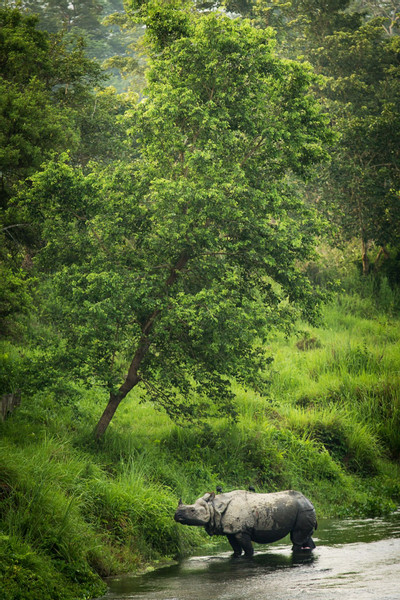The Wildlife of Chitwan
All through the 19th and early 20th centuries, the Chitwan region was popular with big game hunters. The area was remote, taking several weeks to reach from Kathmandu, but hunters would stay for months at a time, shooting hundreds of animals in the process. Remarkably, in 1950 there were still around 800 Indian Rhinos in the area, but poaching and habitat loss increased dramatically when commercial settlement was encouraged – by 1970, 70% of Chitwan’s forests had been destroyed, and a mere 95 rhinos remained. 50 years later, however, dedicated conservation efforts have seen the population in the park recover to over 600, and visitors to Chitwan should be fortunate enough to experience multiple sightings of this armour-plated pachyderm.
Although the reserve was originally established to protect rhinos, Chitwan’s most iconic resident is, without doubt, the mighty Bengal Tiger. Although India is a considerably more famous destination for viewing the world’s largest cat, it is in fact Nepal, and in particular the rich alluvial plains along the foothills of the Himalayas, where this predator reaches some of its highest known densities. However, this wasn’t always the case – in the early 21st century there were little more than 100 Tigers across the whole country. In 2010, all 13 Tiger range states committed to doubling wild populations by 2022; with over 350 resident individuals today, Nepal has far exceeded this goal. No other countries even came close.
More than 100 of these Tigers can be found in Chitwan, where they thrive in the park’s prey-rich forests and grasslands. Although sightings in these dense habitats are not so regular as in the more open woodlands of India, a relatively smaller number of tourists travel to Chitwan, so an encounter with a Tiger is likely to be a considerably more private affair. Nepal also offers something rarely possible in India – the chance to explore Tiger habitat on foot.

Indian Rhinoceros, Chitwan
Providing prey to these predators is a variety of large herbivores, including Wild Boar, Chital, Hog and Sambar Deer, Nilgai and Four-horned Antelope; Gaur (the world’s largest wild cattle) and Asian Elephant, however, are generally too massive to be at risk. The latter species is much less numerous than Nepal’s other megaherbivore, the Indian Rhino – there are perhaps only 250 wild individuals in the entire country. Captive elephants, however, perform a critical role in anti-poaching patrols, and can also be ridden by tourists – a unique means of exploring Chitwan’s more rugged corners.
Flowing to the north and west of the protected area is the Narayani-Rapti river system. This series of waterways provides a natural defence against human encroachment, but is also a superb wildlife habitat in its own right, supporting populations of several highly endangered species. Amongst these are the Ganges River Dolphin and the Gharial, a bizarre, long-snouted crocodilian on the verge of extinction. In the 1950s, an estimated 200 individuals inhabited the river, but this number had dwindled to 38 by the early 21st century. Today, a captive breeding programme is working to supplement the wild population, but the species’ future remains far from certain. The Gharial’s more widespread relative, the Mugger Crocodile, is a more common sight, while additional aquatic carnivores here are Asian Short-clawed and Smooth-coated Otters.
Tiger
Other iconic and unusual birds to be found in Chitwan include Great Hornbill, Lesser Adjutant, Grey-crowned Prinia, Swamp Francolin and Slender-billed Babbler, while Indian Peafowl is conspicuous. Although the majority of the park’s birds are resident, well over 100 species arrive in autumn to overwinter, including Greater Spotted Eagle, Ruddy Shelduck and a wide variety of other raptors and wildfowl. The summer months, too, bring visitors, as migrants arrive to exploit the seasonal abundance of the monsoon; amongst these, Indian Pitta and Indian Paradise Flycatcher are some of the most sought-after. Countless other species can also be found, and Chitwan’s birding is more than a match for its mammal-watching.
In Chitwan, there is superb wildlife at every turn. It is, without doubt, Nepal’s premier national park, supporting unparalleled concentrations of Asia’s most iconic mammals, birds and reptiles. Almost nowhere else on the continent does such a remarkable variety of creatures meet, and in so lush and varied a landscape. As a shining example of a conservation success story, it deserves its place among the world’s great national parks.




 Loading search...
Loading search...